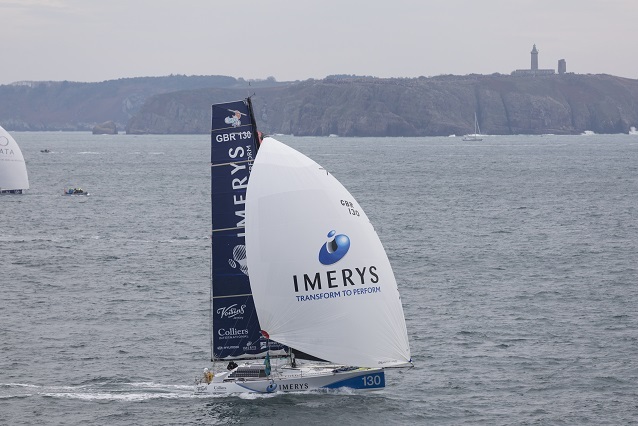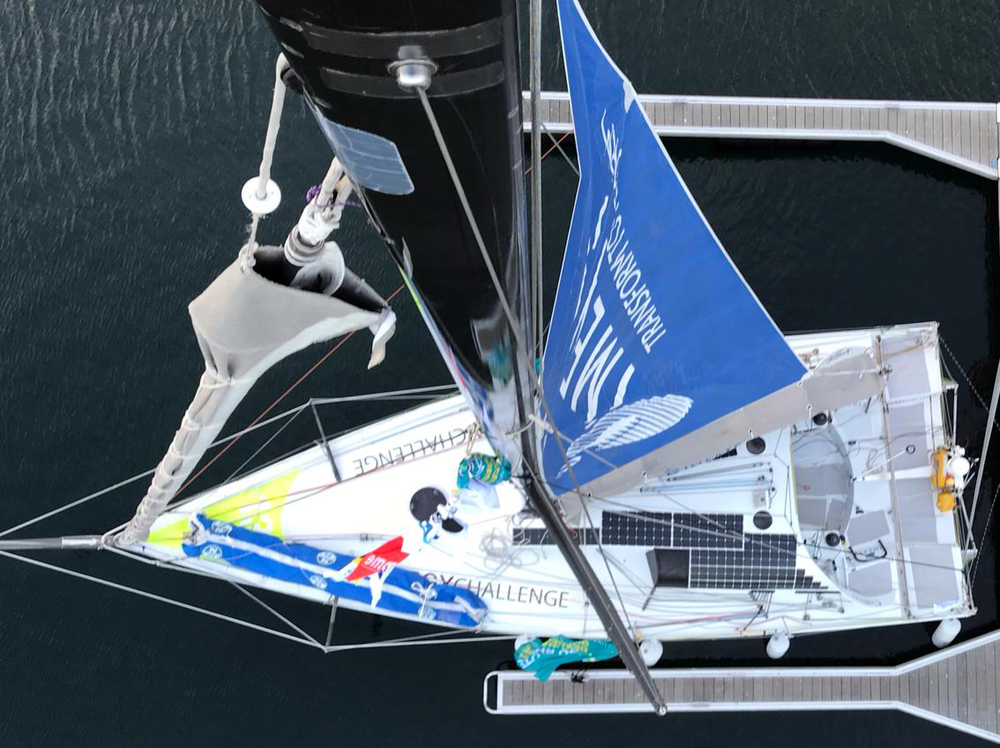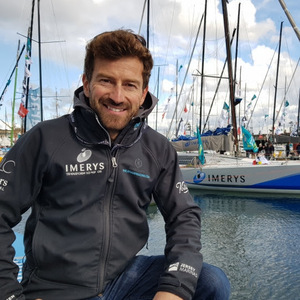B100 helps Phil Sharp take 3rd place in Route du Rhum ocean race




Photo: Phil Sharp Racing
November 20, 2018
BY Ron Kotrba
Biodiesel produced by Renewable Energy Group Inc. and purified with Cynersorb—a surface-functionalized diatomaceous earth from Imerys—helped skipper Phil Sharp of the U.K. take third place out of dozens of participants in this year’s Route du Rhum yacht race in the Class40 category. The solo transatlantic race began in early November at St. Malo in Brittany, France, and ends at Pointe-à-Pitre on the island of Guadeloupe, part of the French West Indies in the Caribbean Sea. The race occurs every four years. Sharp’s sailboat, the Imerys Clean Energy, features a suite of renewable energies, including solar photovoltaic, a hydrogenerator and B100 biodiesel for auxiliary power. Sharp finished the 16-day race Nov. 20.
Winning ocean races while emitting zero carbon dioxide emissions is Sharp’s mission, which is carried out through the Energy Challenge—a high-performance ocean racing project centered on energy efficiency. The project focuses on demonstrating the performance advantages of clean technologies.
“The Energy Challenge is about demonstrating the performance advantages of clean-tech to aid the transition to clean marine power,” Sharp said. “Sailboats may look clean on the outside, but when it comes to their diesel engines and generators, which are used to power motors and onboard electronics, they can be very environmentally dirty vessels.”
Sharp said a typical small cruising yacht could easily release five to 10 pounds of carbon dioxide per day for power and more than 110 pounds a day for propulsion, needed when the wind is light and for maneuvering in and out of port. “For comparison,” Sharp said, “that means a boat releases in one day what a car would release in a full week of commuting.”
While the wind and mainsail provide most of the thrust power needed in the races, Sharp’s boat has computer, communication and navigation equipment onboard that must be powered by energy.
Advertisement
“The boat’s primary source of energy is an array of high-efficiency solar, together with a hydroturbine, used principally at night when boat speeds are sufficiently high,” Sharp said. “The main engine on the boat, powered by advanced biodiesel, provides backup power in case of light winds and low-light conditions.”
According to Chris Abrams, commercial development manager for Imerys Filtration, 40 liters of B100 was used just in getting the Imerys Clean Energy out of dock and underway.
“We chose a solid partner in REG and we’re confident of our product,” Abrams told Biodiesel Magazine. “For us, the clean energy boat using biodiesel from one of our customers shows confidence in and support for the product.”
Sharp’s wife Rebecca, commercial director of Phil Sharp Racing, said that before starting the race, the Imerys Clean Energy had to motor for 20 minutes across to Dinard from St. Malo. “Normally, I can’t stay down below because the smell of diesel makes me feel terrible,” she told Biodiesel Magazine. “But in this case, there was no smell and I could stay hiding away from the freezing cold!”
Sharp said even though biodiesel is more expensive and “considerably less accessible” than petroleum diesel fuel, “these factors will become less restrictive with increased uptake once more boat owners accept that it is our duty to be responsible for our environment. This is now our second season racing with clean energy and we hope that our strong race results will motivate others to ‘be clean on the inside as well as the outside’—to be responsible in limiting their air pollution on the ocean, and set an example for the industry to follow.”
Advertisement
Rebecca said Sharp and the racing team are developing additional clean energy technologies for the Class40 boat. “We are currently mid-development of a hydrogen-electric system with the future aspiration of being off-grid with an onboard electrolyzer and capturing energy from solar and the hydrogenerator,” she said.
Sharp’s Energy Challenge may be considered rogue by some, since racing regulations for Class40 boats are in place to keep costs down. “This actually impedes the innovation of clean-tech on the race boats,” Rebecca said. “We have gotten around this by integrating biodiesel. Previously, before this partnership, Phil was forced to race with diesel—which he did not use during the race, giving a weight penalty.”
In addition to the REG biodiesel onboard having been cleaned by Imerys’ CynerSorb filtration product, Imerys also provided abrasives on the solar panels installed on the deck, which offer anti-slip properties and increase the durability of the panels.
Abrams and Rebecca said this has been a tough race of attrition, with a number of contestants dropping out due to maintenance issues or bad weather.
“Route du Rhum” translates from French as “Rum Road.” The liquor distilled from molasses originated in the West Indies.
Related Stories
Airbus is taking a significant step toward scaling the adoption of sustainable aviation fuel (SAF) by testing a new “Book and Claim” approach. This initiative aims to boost both supply and demand for SAF worldwide.
Signature Aviation, the world’s largest network of private aviation terminals, has announced the expansion of its blended SAF offering at six new locations across Europe following multiple blended SAF supply agreements.
Virgin Australia has entered an agreement with Viva Energy to SAF for its flights departing from Proserpine, Queensland. The SAF will consist of Jet A1 and a 30-40% synthetic blend component made from waste and residue feedstocks.
The largest single volume order of sustainable aviation fuel (SAF) by a DB Schenker customer has been placed by Mercedes-Benz. The order is for approximately 13,000 metric tons of SAF and is expected to reduce CO2 emissions by 40,000 metric tons.
ADM and Loyola University Chicago Searle Biodiesel Lab have joined the expanding B20 Club. Founded in 2014, the B20 Club is a partnership between the Illinois Soybean Association and American Lung Association.
Upcoming Events










